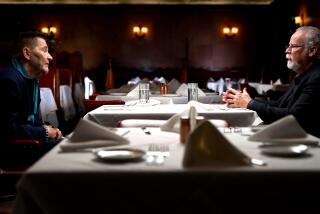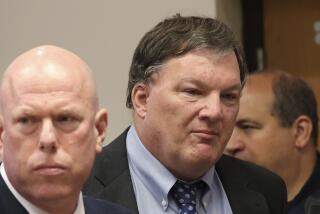Jury Views Grim Photos of Slaying Victim’s Body : Court: Despite defense’s objections, judge allows pictures of Kellie O’Sullivan in decomposed state to be shown as deputy coroner testifies in Mark Scott Thornton’s murder trial.
- Share via
Despite earlier reservations against allowing jurors to see pictures of Kellie O’Sullivan’s badly decomposed body, a judge allowed two gruesome autopsy photographs to be shown Monday at Mark Scott Thornton’s murder trial.
Superior Court Judge Charles R. McGrath’s decision came over vehement objections from attorneys for the 20-year-old defendant, who prosecutors say shot and killed the nurse Sept. 14, 1993, and stole her truck.
“The prejudicial aspect of this is enormous,” Deputy Public Defender Howard J. Asher said of the photographs.
The pictures were taken shortly after O’Sullivan’s body was found in the Santa Monica Mountains 12 days after her disappearance and shooting death. McGrath also allowed the jury to see four photos of the heavily soiled clothes the nurse was wearing when her body was found.
Prosecutors had asked the judge to allow the jury to see the photographs so they could better understand complex testimony from Dr. James Ribe, the Los Angeles County deputy coroner who conducted the autopsy in the case. Ribe was the only witness to take the stand Monday.
“Granted, they are not pleasant,” Deputy Dist. Atty. Peter D. Kossoris said of the pictures. “But murder isn’t pleasant.”
McGrath agreed the photographs depicted a horrible sight.
“I’ve viewed the photographs,” said the judge, who has presided over more than 30 murder trials in his two decades on the bench, “and they are as unpleasant as any photographs I have had to look at.”
*
Nonetheless, McGrath said the pictures would be beneficial for the jury.
Though jurors looked intently at the photos, their facial expressions betrayed no shock at what they were seeing.
McGrath’s decision came two months after he ordered prosecutors not to show two other gruesome pictures of the body from the crime scene. In that ruling, he gave permission for a third, less horrific photograph from the scene to be shown during the trial. He ordered prosecutors to touch up the picture.
Ribe’s testimony began the fourth week of Thornton’s murder trial. If convicted of first-degree murder under a special circumstance--robbery or kidnaping--the young defendant could be sentenced to death in the gas chamber.
Ribe told the jury that O’Sullivan was shot once in the chest and twice in the back and that her assailant appeared to have fired his gun from a downward angle.
That supported testimony from a ballistics expert, who told the jury last week that O’Sullivan appeared to have been kneeling when she was shot.
Prosecutors have theorized that the nurse did not expect to be shot, noting that she apparently was still carrying her purse and some personal papers when her life was taken. Had she expected to be shot, they have said, she would have tried to struggle with her attacker.
Under cross-examination, Asher asked Ribe if he were sure that the nurse was on the ground and shot by someone standing above her. He was not 100% sure, Ribe responded, but he maintained that his testimony was the most probable scenario.
“Obviously, I wasn’t there when she was shot,” the forensic pathologist told Asher. “So I don’t know for a fact what position she was in.”
*
Ribe also testified that there was no evidence to indicate that O’Sullivan struggled before the shooting. But her body was so badly decomposed, he said, that evidence that would have indicated a struggle--such as bruises or other marks--probably would not have been visible by the time the body was found.
The decomposition was so advanced, Ribe said, that he initially thought O’Sullivan had been shot all three times in the back. But on closer inspection, he was able to determine that one shot--probably the first one--struck the woman in the chest, Ribe said.
He also said O’Sullivan probably lost consciousness within 30 seconds to a minute after being shot first in the chest. That bullet, he said, ripped through her aorta of the left lung, causing her to bleed profusely, he said.
More to Read
Sign up for Essential California
The most important California stories and recommendations in your inbox every morning.
You may occasionally receive promotional content from the Los Angeles Times.













